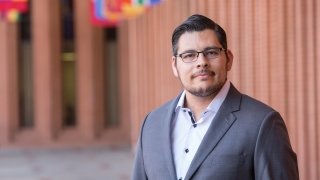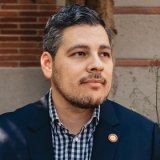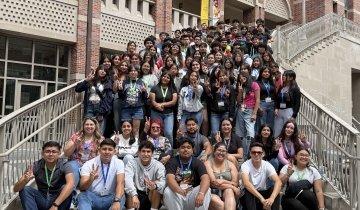Stephen J. Aguilar, Assistant Professor of Education, joins a distinguished list of USC Rossier colleagues who were recognized for their contributions to education research. He discusses his recent American Education Research Association (AERA) awards, his work to mitigate the digital equity gap and the new USC Center for Generative AI and Society.
Your work addresses the digital equity gap. Can you talk a little bit about that, and how you’re working to mitigate it?
The digital equity gap is a gap caused by misunderstanding the sociotechnical system where students learn. For example, if I were to give you a computer, but you didn’t have electricity, you wouldn’t be able to use it. Similarly, if you knew how to use a computer, but I gave you an old machine that was constantly crashing, your knowledge may not be enough to make use of it. That’s the sociotechnical system—it’s all of the additional “stuff” that enables us to use a given technology effectively. When an essential piece is missing, technology hinders rather than helps.
My work aims to document these missing pieces and find ways to address them. During the pandemic, this meant documenting instances where high speed broadband internet wasn’t available to underserved students in Los Angeles. My work, in collaboration with others across USC, contributed to legislation that helped make broadband internet affordable. But there is more work to be done.
You and a team of collaborators across USC were awarded an NSF grant to make coding accessible for people with disabilities. How is that going?
It’s busy! This isn’t a typical NSF grant. The NSF Convergence Accelerator focuses on enabling teams to address a pernicious societal issue and rapidly develop a solution for it over nine months. The team I am a part of is focused on supporting persons with motor disabilities who are interested in entering the digital economy. By the end of the project period we will have a prototype that will enable persons with physical disabilities to engage with off-the-shelf coding courses. Our aim is to support individuals ability to “skill up” independently. We hope to make the case for phase two funding as well, which will enable us to scale our solution in a sustainable way.
You’ve talked about AI in the classroom, for example in a recent Washington Post article. Let’s look forward, how can teachers use it? How can teachers use AI for critical thinking? Do you have any tips for educators?
At this stage, generative AI is best suited as a productivity accelerator that still requires expertise, because it’s still going to make mistakes. Teachers, for example, might use generative AI to accelerate different workflows involved with lesson planning. They could ask ChatGPT to draft a five-step lesson plan. The operative term here is “draft”—teachers still need to change it to suit their needs and the needs of their students. Not having to write from scratch will save time.
Teachers can also use generative AI to help their students think critically. As a drafting tool, ChatGPT could be used to help students move beyond the blank page and edit writing, instead of writing from scratch. Teachers can also use mistakes in text they find as artifacts their students interrogate. For now, at least, I think the above examples are places generative AI can shine. I do not think it’s ready to replace experts—regardless of sector.
USC recently announced the new USC Center for Generative AI and Society. I understand that you will play a role in that. Can you discuss what you will be doing there?
We have three branches of work that we’re pursuing basically all at once. The first we’ll be starting over the summer is an AI fellows program. We plan on recruiting anywhere from 15 to 20 USC instructors who are excited about the potential use for generative AI. We’ll follow them and their students for a year to capture best practices and pain points. Second, we will establish a way to understand how students edit AI-generated text. Are they engaging with concepts? Do they find some sort of logical fallacy in the text, and they’re editing that so that it’s logical and valid? Finally, we will write a series of reports that focus on national implications of generative AI in post-secondary settings. This work is needed, as we actually don’t know what’s happening broadly and at scale in terms of how students are engaging with generative AI technologies.
AERA is the nation’s largest education conference. What does the AERA Division C Early Career and 2022 Outstanding Reviewer mean to you?
It’s an honor winning the Division C Early Career Award. Division C is the second largest division of AERA, and is the primary home of my fellow educational psychologists. More than anything, I am grateful that my research agenda thus far resonates with my colleagues. It’s an incredibly meaningful award for me and a signal that the work I’m doing is having an impact within the academy as well as outside of it.
I am also grateful for being recognized as an Outstanding Reviewer for AERA Open. As a reviewer, you never know if your suggestions actually help, but this award is a signal that the feedback I’ve given my colleagues is helpful.





